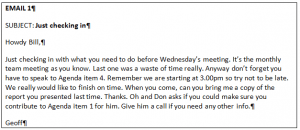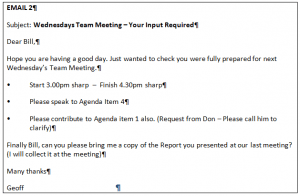
11 Jul 2014 Boost your professional email writing with these 3 tips
Boost your professional email writing with these 3 tips
Email is the business communication medium of choice for the great majority of business. It is used by all of us on a daily basis. However, many of us could improve our professional email writing by taking on board the following 3 suggestions.
In my work, I constantly see examples of poorly written emails, and I’ve probably been guilty of doing it myself sometimes too!
When we are in a rush, it is too easy to forget there are certain protocols with email that we should keep in mind if we want to communicate more successfully.
For this short piece, I would like to focus on just 3 key points you will want to remember that will help you write more professional emails that are more likely to be read and get noticed.
1 – Write a Meaningful Subject Line
Firstly, make sure you write a meaningful and effective subject line.
Actually, in the first instance, please make sure you have included a Subject Line, full stop! We’ve all been guilty of leaving one out from time to time, but we all know how frustrating it is to receive an email without a subject line too!
Thankfully, Outlook 2013/16 and 365 now reminds you that you have not included a Subject Line, so this should not happen often. (Good move Microsoft!)
Anyway, let’s examine the following subject lines.
| From | Subject | Received |
| Anyone | Productivity Conference on Monday – What to bring | |
| Anyone | Conference on Monday | |
| Anyone | Monday | |
| Anyone | Please Read! | |
| Anyone |
Which of the above email subject lines is “professional email writing” standard? Which one are you more likely to take notice of?
I think the top Subject Line is the one most of us will agree is the most professional email subject line. It tells you exactly what the email is about and you are more likely to open knowing exactly what it contains.
The second one is not too bad either, but unless you had an idea why you are getting this email, you may not open it until too late. That is, the morning of the conference might be too late for you to organise the things you needed to bring along with you.
The subject line “Monday” is poor…. I think we can all see why.
The subject line “Please Read” is also poor, but you also risk the email not being read at all. Naturally context is important, so it may suffice in some situations, but it is not recommended.
And finally, no subject line! Enough said already.
2 – No “Open Ended” Contracts
By this I mean, if you need an answer to an email by a certain date, then say so and make it very clear what your deadline is.
A professionally written email should make it easy for your recipient to plan their time by giving them a clear idea of your time frame. Simply state when you need an answer.
By the way, “ASAP” or “It’s not urgent.” do not constitute a due date! Agreed? Far too open to interpretation.
If you receive an email with no date specified for a response, then maybe send an email straight back and ask when they require a response or you could indicate when you are likely to be able to respond. You may well get an email straight back stating exactly when they do need a response. In other words, “Close the Contract”.
3 – Keep your Emails brief and to the point
I think I have save the best till last. These days, we have become used to skimming emails briefly and responding accordingly. In fact, we often get so many emails that we are forced to skim quickly just to get through our emails.
And of course, many emails are now read on our mobile phones. We all know how hard it is to read long emails on a phone.
Use “Brevity” in your email correspondence and make it easier for your recipient to read your email quickly and pick up on your key points.
Dot Points are very effective but it is surprising how little they are used in email correspondence. No reason why not though. Most email programs now use HTML formatting (as opposed to using Plain Text). Meaning you can use most of the usual formatting options you have when using MS Word for instance. (including coloured text)
Consider which of the following two emails will most likely be read and understood quickly.
I’m pretty sure we can all agree that Email 2 is a far better way of presenting an email to a recipient. It increases the likelihood of your email being well understood and will be far more effective in the long run.
Professional Email Writing
Taking the time to write more professional emails is well worth the effort in my opinion. We all want our emails to be read and to be understood. So take some to improve your professional email writing skills by working on the 3 tips outlined in this little article.
In my next Blog, I will add a few more hints to this list, but hopefully these three email tips are enough to get you started down the path of writing more professional looking emails.
And appreciate any comments or feedback you may have of course! For more time management tips like this, see our Email Productivity Training
Geoff Prior – Lingford Consulting, July 2014
Workload & Email Management Training/Coaching. MBTI Consultant





No Comments